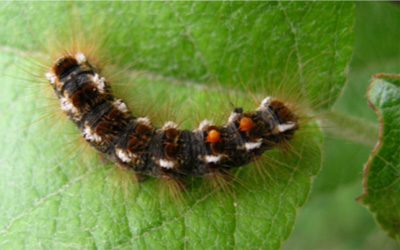
Photo credit: Maine Dept. of Agriculture, Conservation, and Forestry
About Browntail Moths
What are Browntail Moths?
The browntail moth is an invasive species found only in Maine and Cape Cod. The caterpillars reach about 1.5 inches in length and are brown. They have a broken white stripe on each side and two red-orange spots on the hind end. They are a forest health concern because the caterpillars can damage trees. They are also a human health concern because they have toxic hairs that can cause health problems in some people.
When are Browntail Moths Active?
Caterpillars are active from April to late June. Hairs remain toxic in the environment for up to three years but lose strength over time.
Browntail Moths and Your Health
Browntail moth caterpillars have tiny hairs on their bodies that they shed into the environment. These hairs are irritating to skin and also contain a toxin. People may develop skin irritation similar to poison ivy from direct contact with the caterpillar or indirectly from contact with hairs in the air or environment. Most people develop a localized rash that lasts for a few hours up to several days. Some sensitive people can have a severe rash that lasts for several weeks. If inhaled, some people can experience breathing problems that can become severe and require emergency medical attention.
Symptoms
- Skin rash
- Difficulty breathing
There is no specific treatment for browntail moth rash. Home remedies can help with symptoms. These can include:
- Taking a cool bath with baking soda
- Hydrocortisone cream
- Calamine lotion
If you are having trouble breathing, swallowing, or have swelling of your mouth, tongue, or throat, seek emergency medical care.
How to Prevent Browntail Moth Rash
- Take a cool shower and change clothes after activity in areas with browntail moths to wash off any hairs.
- Wear a mask, goggles, and coveralls when doing any activity that can stir up browntail moth hairs. This can include raking leaves, mowing the lawn, etc.
- Dry laundry inside during June and July to prevent browntail moth hairs from getting on clothing.
- Perform yard work and clipping on wet days so browntail moth hairs do not get stirred up.
Public Health Nuisance Declaration for Municipalities
Public Health Nuisance Declaration
Pursuant to Maine Statute Title 22, §1444 the Director of Maine CDC can declare an infestation of browntail moths (BTM) as a public health nuisance*. The declaration may be made on the Director's initiative or upon petition by municipal officers. Below is the process for declarations made upon petition by a municipality.
- A public health nuisance is defined as any activity or failure to act that adversely affects public health. Examples include improperly stored solid waste such as rotting garbage or dead animals, or insect or rodent infestations.
What does a public health nuisance declaration do?
A public health nuisance declaration allows a municipality to take actions to address an issue of public health concern affecting the community. Where browntail moths are concerned, a declaration can allow the municipality to use public municipal funds on private lands to control for browntail moth populations. More specifically, a municipality may conduct aerial spray operations to target browntail moth infestations pursuant to Maine Statute Title 22, §1444. Other options may be available to control browntail moth populations and should be discussed with Maine Forest Service. A declaration can provide a municipality with more options for browntail moth treatment that may not have otherwise been available absent the declaration. A declaration does not provide access to additional state funds or services.
How to petition for a Public Health Nuisance Declaration
- Municipalities Should a municipality wish to petition for a public health nuisance declaration the process is as follows:
- The municipality must complete the BTM Public Health Nuisance Request Form (Word) on town letterhead.
- A letter from the Maine Forest Service, documenting the infestation in the town, shall accompany the Request for a BTM Public Health Nuisance Request form.
- The municipality must have a letter from their local health officer supporting the request.
- The municipality should submit the documentation to Infectious Disease Epidemiology, Division of Disease Surveillance, Maine CDC by mail, fax, or e-mail
- Mailing Address: 11 State House Station, 286 Water Street, Augusta ME, 04333-0011
- Fax number: 207-287-6865
- E-mail address: disease.reporting@maine.gov
- Maine CDC
- A copy will be made of the request upon receipt by Division of Disease Surveillance staff.
- One copy will be submitted to the Director for review and signature; the second copy will be provided to the vectorborne epidemiologist, who will notify the Maine Forest Service (State Entomologist) of the request.
- If approved, petitions submitted from January 1 to August 31 will expire on December 31 of the current year. Petitions submitted from September 1 to December 31 will expire on December 31 of the following year.
- The form, indicating approval or denial and signed by the Maine CDC Director will be returned to the municipality via US mail.
Resources
Browntail Moth Factsheets
- English (PDF)
- Français">عربي | Français (PDF)
- Kreyòl Ayisyen (PDF)
- Lingala (PDF)
- Português (PDF)
- Soomaali (PDF)
- Español (PDF)
- Tiếng Việt (PDF)
- Knock Out Browntail Brochure (PDF)
- Knock Out Browntail - Maine Dept. of Agriculture, Conservation, and Forestry
- Interactive Browntail Moth Dashboard
Contact
Contact 211 Maine with questions
Dial 211, text your zip code to 898-211, or email info@211maine.org
